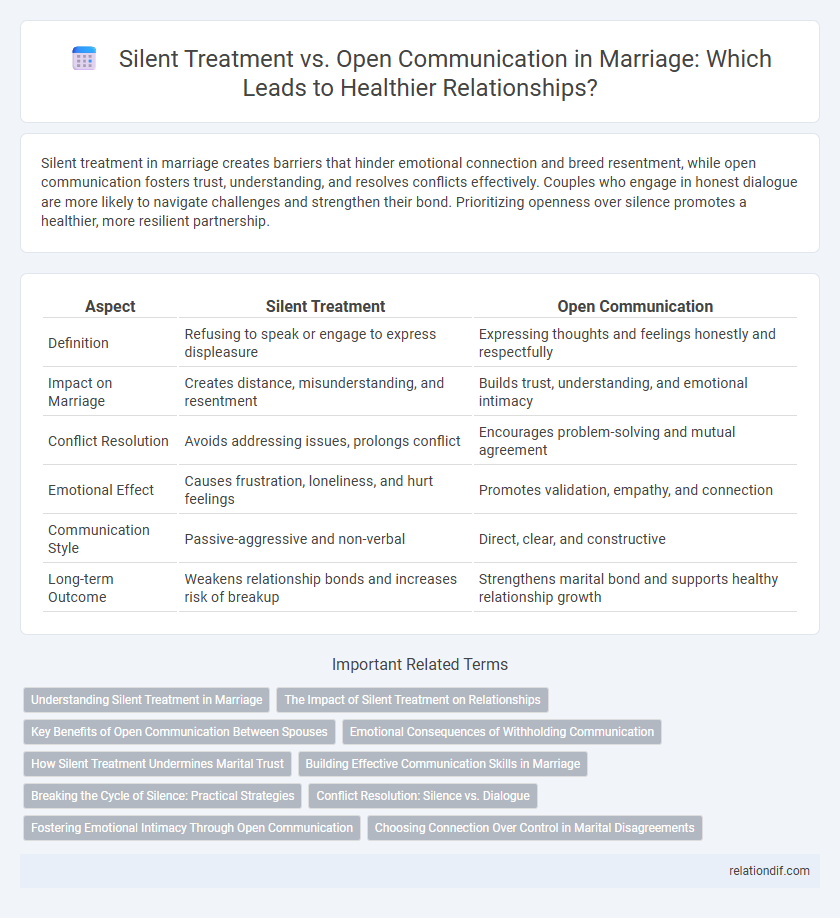Silent treatment in marriage creates barriers that hinder emotional connection and breed resentment, while open communication fosters trust, understanding, and resolves conflicts effectively. Couples who engage in honest dialogue are more likely to navigate challenges and strengthen their bond. Prioritizing openness over silence promotes a healthier, more resilient partnership.
Table of Comparison
| Aspect | Silent Treatment | Open Communication |
|---|---|---|
| Definition | Refusing to speak or engage to express displeasure | Expressing thoughts and feelings honestly and respectfully |
| Impact on Marriage | Creates distance, misunderstanding, and resentment | Builds trust, understanding, and emotional intimacy |
| Conflict Resolution | Avoids addressing issues, prolongs conflict | Encourages problem-solving and mutual agreement |
| Emotional Effect | Causes frustration, loneliness, and hurt feelings | Promotes validation, empathy, and connection |
| Communication Style | Passive-aggressive and non-verbal | Direct, clear, and constructive |
| Long-term Outcome | Weakens relationship bonds and increases risk of breakup | Strengthens marital bond and supports healthy relationship growth |
Understanding Silent Treatment in Marriage
Silent treatment in marriage often reflects unresolved conflicts and emotional withdrawal, causing significant strain on trust and intimacy. Understanding the underlying reasons, such as feelings of hurt, frustration, or fear of confrontation, is crucial for breaking the silence. Couples who prioritize open communication create a healthier environment that fosters emotional connection and conflict resolution.
The Impact of Silent Treatment on Relationships
Silent treatment in marriage often leads to emotional distance, increased resentment, and weakened trust between partners. Studies reveal that couples who avoid open communication experience higher levels of stress and lower relationship satisfaction. Consistent use of silent treatment disrupts healthy conflict resolution and can escalate conflicts, making it crucial to foster transparent dialogue for marital stability.
Key Benefits of Open Communication Between Spouses
Open communication between spouses fosters trust, emotional intimacy, and effective conflict resolution, creating a strong foundation for a healthy marriage. It encourages vulnerability and understanding, allowing partners to express their needs and feelings without fear of judgment or resentment. Transparent dialogue reduces misunderstandings, preventing the emotional damage often caused by the silent treatment and promoting long-term relationship satisfaction.
Emotional Consequences of Withholding Communication
Withholding communication in marriage often leads to emotional distress, including feelings of isolation, resentment, and anxiety. Silent treatment can erode trust and intimacy, creating a barrier that prevents conflict resolution and mutual understanding. Open communication fosters emotional safety, enabling couples to express vulnerabilities and strengthen their emotional connection.
How Silent Treatment Undermines Marital Trust
Silent treatment in marriage erodes trust by creating emotional distance and fostering feelings of rejection and insecurity between partners. Open communication promotes transparency and mutual understanding, which are essential for building and maintaining marital trust. Persistent silence disables conflict resolution and deepens resentment, ultimately weakening the foundation of the marital relationship.
Building Effective Communication Skills in Marriage
Silent treatment creates emotional distance and hinders conflict resolution in marriage, undermining trust and intimacy. Open communication fosters understanding and empathy, enabling couples to address issues collaboratively and strengthen their emotional connection. Developing effective communication skills, such as active listening and expressing feelings honestly, is essential for maintaining a healthy and resilient marital relationship.
Breaking the Cycle of Silence: Practical Strategies
Breaking the cycle of silence in marriage requires fostering open communication through active listening and expressing emotions honestly. Couples can implement regular check-ins and use "I" statements to share feelings without blame, promoting understanding. Establishing a safe space for dialogue helps replace the silent treatment with constructive conversations that strengthen trust and connection.
Conflict Resolution: Silence vs. Dialogue
Resolving conflicts in marriage is more effective through open communication, which promotes understanding and emotional connection, unlike silent treatment that often breeds resentment and misunderstanding. Couples who engage in honest dialogue address issues directly, fostering mutual respect and problem-solving. Silent treatment creates emotional distance, hindering resolution and potentially escalating conflicts over time.
Fostering Emotional Intimacy Through Open Communication
Open communication in marriage fosters emotional intimacy by encouraging partners to share their thoughts, feelings, and concerns honestly and respectfully. Unlike the silent treatment, which creates distance and misunderstanding, open dialogue builds trust and strengthens the connection between spouses. Practicing active listening and expressing vulnerability enhances mutual empathy and deepens emotional bonds.
Choosing Connection Over Control in Marital Disagreements
Silent treatment in marriage often breeds resentment and emotional distance, undermining trust between partners. Open communication fosters understanding and empathy, enabling couples to address conflicts constructively and strengthen their bond. Choosing connection over control prioritizes emotional intimacy, promoting long-term relationship resilience and mutual respect.
Silent treatment vs Open communication Infographic

 relationdif.com
relationdif.com